#Central Utah Relocation Center (Topaz)
Photo

My father, Susumu Yamashita, was a junior executive at the San Francisco branch of Mitsubishi trading company before the December 7, 1941 Japanese attack at Pearl Harbor. On April 30, 1942, he was involved in the mass forced removal of the Japanese American community from Berkeley to Tanforan detention center, a former race track in San Bruno, with my mother, Kiyoko Yamashita, and my 18 month-old sister Kimiko. My family was housed in a horse-stall “apartment” from May to September. When my family was transported to the Topaz, Utah incarceration camp in September 1942, my father was assigned to be the liaison to the Issei (first-generation) residents due to his Japanese-language proficiency, which was gained from his 11 years of education in Tokyo between 1911–1922. This is why he was labeled as a “Kibei,” American born but educated in Japan. After working 14 months in Community Welfare, providing the camp’s social services, my father was ready for a change. My Cal Berkeley/Harvard Business School-alumnus, ex-businessman father asked to be transferred to the agricultural division to work as a ranch hand. He achieved personal satisfaction from working outdoors as a Kibei cowboy, tanned and healthy, herding cattle astride his favorite horse, Red. At age 39, he was undoubtedly one of the oldest “cowboys” amongst the riders at the Topaz cattle ranch. In 1951 he rejoined Mitsubishi and was charged with establishing its New York headquarters as the new Mitsubishi International Corporation. After Topaz, my father never rode a horse again.
Michael Yamashita
#Susumu Yamashita#western riding#Utah#Topaz War Relocation Center#Central Utah Relocation Center (Topaz)#world war II#WWII#Michael Yamashita
170 notes
·
View notes
Video
youtube
The Topaz War Relocation Center, also known as the Central Utah Relocation Center (Topaz) and briefly as the Abraham Relocation Center, was an American concentration camp that housed Americans of Japanese descent and immigrants who had come to the United States from Japan, called Nikkei. President Franklin Roosevelt signed Executive Order 9066 in February 1942, ordering people of Japanese ancestry to be incarcerated in what were euphemistically called "relocation centers" like Topaz during World War II. Most of the people incarcerated at Topaz came from the Tanforan Assembly Center and previously lived in the San Francisco Bay Area. The camp was opened in September 1942 and closed in October
Learn more
0 notes
Text
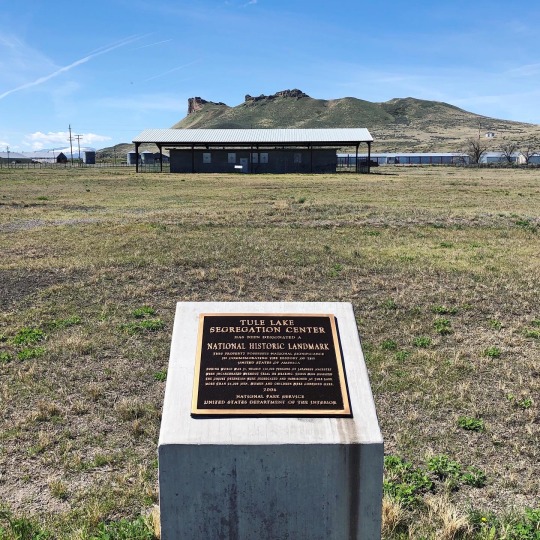
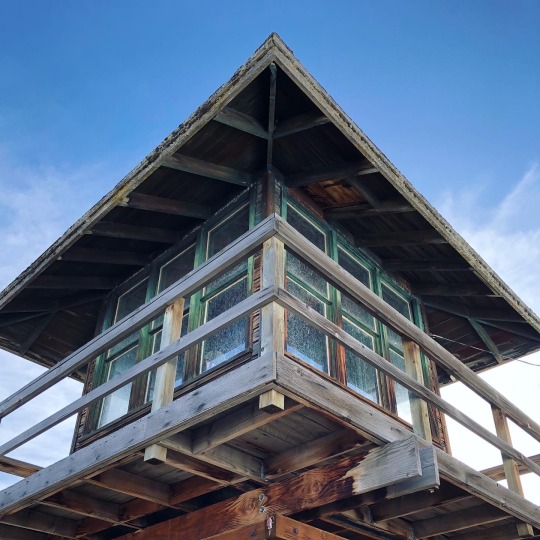

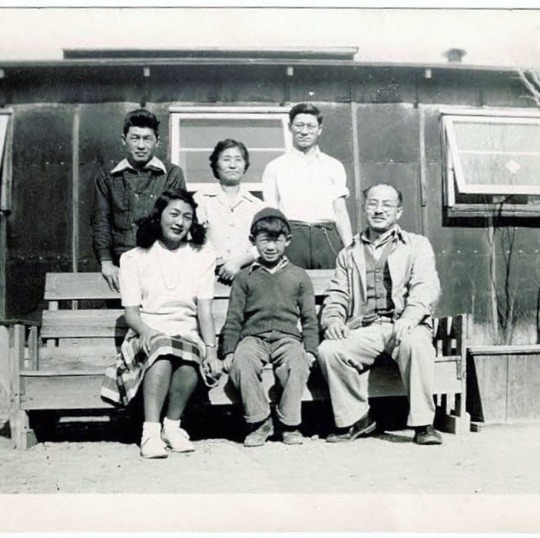
Today is Day of Remembrance. On this day, February 19, in 1942, President Franklin D. Roosevelt signed into law Executive Order 9066, which paved the way for the mass incarceration of people of Japanese ancestry in World War II. This morning, I’d like to share some of my memories of learning more about the incarceration with you:
1. Tule Lake Segregation Center (2019): This was the third incarceration site I ever visited, on the California/Oregon border. Although much of the site has been lost to modern development, some of the original buildings, barbed wire fencing, and the jail (under the awning in the photo), built in 1945, remain.
2. Tulelake-Butte Valley Fairgrounds (2019): Near the former incarceration site at Tule Lake is a museum at the Tulelake-Butte Valley Fairgrounds. The museum is fairly small, but most striking to me was seeing one of the original guard towers in the yard. My step-grandparents were imprisoned at Tule Lake—I can’t help wondering if this was one of the guard towers they passed every day, on their way to the mess hall or to school.
3. Central Utah Relocation Center, also known as Topaz (2007): My mom and aunt took me on my first pilgrimage to Topaz back in 2007. This is me standing in the site of my grandpa’s old barracks. This was where he lived. For three years, with these strange horizons, behind barbed wire, this was where he lived. Photo by Kats Kitagawa.
4. Central Utah Relocation Center, also known as Topaz (c. 1942-1945): This is my grandpa and his family at the very same barracks during the incarceration. Because most cameras were confiscated after the attack on Pearl Harbor, we don’t have a lot of photographs from inside the camps, but there are a few, and they are precious—glimpses of these hard years, these injustices. I haven’t forgotten, family. I hope we never forget.
5 notes
·
View notes
Photo

New Year’s Eve at Topaz internment camp, Central Utah Relocation Center, for Americans of Japanese ancestry. December 31, 1945. [1161 x 862] Check this blog!
6 notes
·
View notes
Photo

Topaz, Utah. James Wakasa funeral scene. 4/19/1943
Series: Central Photographic File of the War Relocation Authority, 1942 - 1945. Record Group 210: Records of the War Relocation Authority, 1941 - 1989
An internee of the Topaz War Relocation Center, James Wakasa was shot and killed by a military sentry on April 11, 1943 while walking near the camp fence.
Browse nearly 4,000 photos of Japanese American relocation and internment in the Central Photographic File of the War Relocation Authority in the @usnatarchives online catalog.

More Resources Commemorating the 75th Anniversary of Japanese American Internment at the National Archives
#Japanese American Internment#World War II#funeral#James Wakasa#internment#relocation#Topaz Relocation Center#Topaz#Utah#ww2#WWII75#japanese american relocation#archivesgov#April 19#1943#1940s#Asian American history
66 notes
·
View notes
Photo
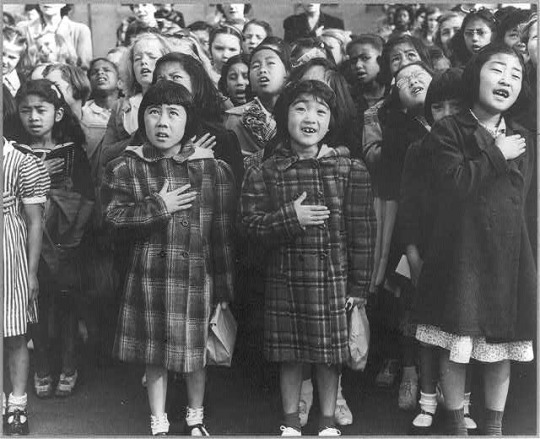
San Francisco, Calif., April 1942 - Children of the Weill public school, from the so-called international settlement, shown in a flag pledge ceremony. Some of them are evacuees of Japanese ancestry who will be housed in War relocation authority centers for the duration
ummary: Photograph shows multi-ethnic group of schoolgirls at the Raphael Weill Public School with their hands on their hearts saying the Pledge of Allegiance. Included in the photograph are Helene Mihara née Hideno Nakamoto (front row, Japanese American girl in plaid coat on the left) and Mary Ann Yahiro née Yoko Itashiki (front row, Japanese American girl in plaid coat on the right). In February 1942, Hideno's father, Jitsuzo Nakamoto, a San Francisco businessman, was arrested and incarcerated at Fort Lincoln, a Department of Justice camp for "enemy aliens" in Bismarck, North Dakota. He was later transferred to Lordsburg Internment Camp, Lordsburg, New Mexico, before being reunited with his family 15 months later at Tule Lake Relocation Center in Newell, California. Soon after the photograph was taken, Hideno, her mother, Fusaye, and her sister, Takako, were forcibly removed to Tanforan Assembly Center before being transferred to Tule Lake Relocation Center and later Central Utah Relocation Center, Topaz, Utah. Yoko's mother, Fuku Ogura Itasaki, a Japanese language teacher, was also arrested as an "enemy alien" and incarcerated at Camp Sharp Park, Sharp Park, California. She died there before being reunited with her family. Yoko's father, Torozimen Itashiki, and the rest of the family were forcibly removed to Tanforan Assembly Center before being transferred to Topaz. (Sources: interview with Helene Mihara, Nov. 29, 2021; Kitagaki, Paul, Jr. Behind barbed wire, 2019, page 29)
Reproduction Number: LC-USZ62-17124 (b&w film copy neg.)
Rights Advisory: No known restrictions on publication.
Call Number: LOT 1801 [item] [P&P]
Other Number: J 6738
Repository: Library of Congress Prints and Photographs Division Washington, D.C. 20540 USA https://hdl.loc.gov/loc.pnp/pp.print
Notes:
0 notes
Text
Central Utah Relocation Center (Topaz Internment Camp)
Central Utah Relocation Center (Topaz Internment Camp)
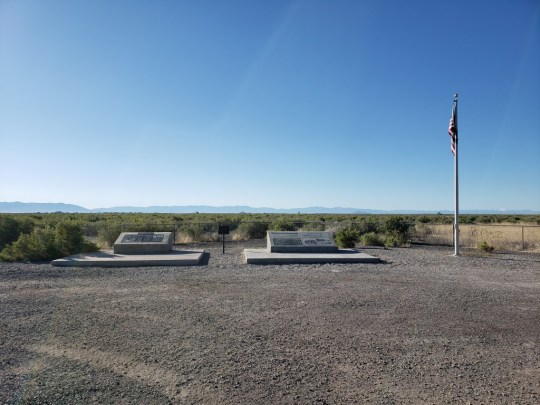
Central Utah Relocation Center (Topaz Internment Camp) has been designated a National Historic Landmark.
On February 19, 1942, President Franklin D. Roosevelt signed Executive Order 9066. Without any judicial hearings and due process of law, more than 120,000 persons of Japanese ancestry were forcibly uprooted from their homes and taken under armed guard for relocation and detention in a…
View On WordPress
0 notes
Photo
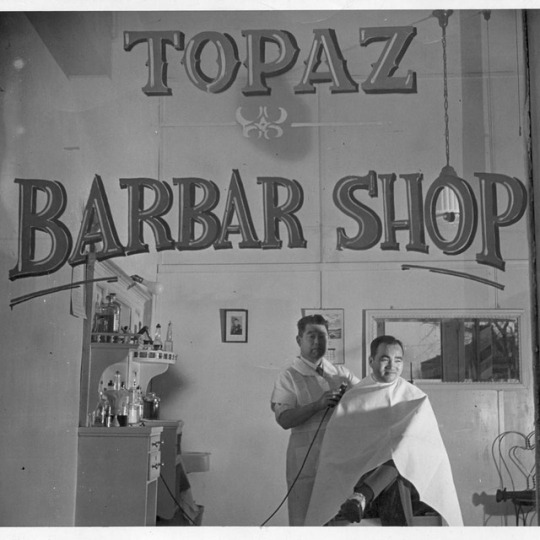

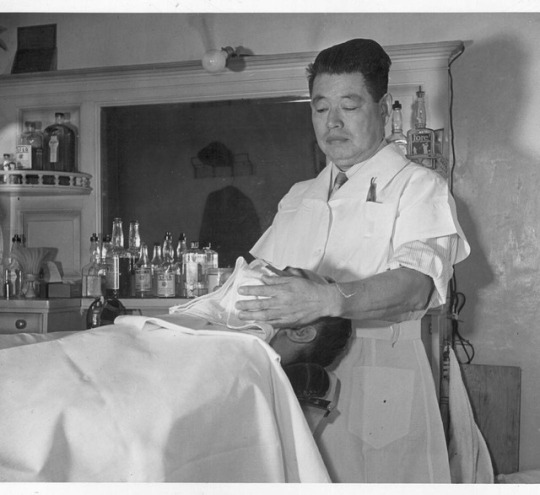
Source: Instagram: http://www.instagram.com/ardronkurt1975
This is Mr. Suzuki's story... Yonezo Suzuki, 539 West Second, South, owner and operator of the Topaz Barber Shop. Yonezo was evacuated from San Francisco, California, to the Central Utah Relocation Center and lately was given leave clearance to establish his own barber shop, which he named after the post office address of this relocation center for evacuees of Japanese ancestry. He was born at Shiga-Ken, Japan, but has spent many years in the United States, and served in the infantry from Hawaii in the last year. He became a naturalized citizen November 6, 1936, in San Francisco. For six years he was Finance Manager of the Townsend-Harris Post. Photo shows Yonezo practicing his tonsorial art on a fellow Japanese-American. -- Photographer: Stewart, Francis -- Topaz, Utah. 3/29/43
3 notes
·
View notes
Photo
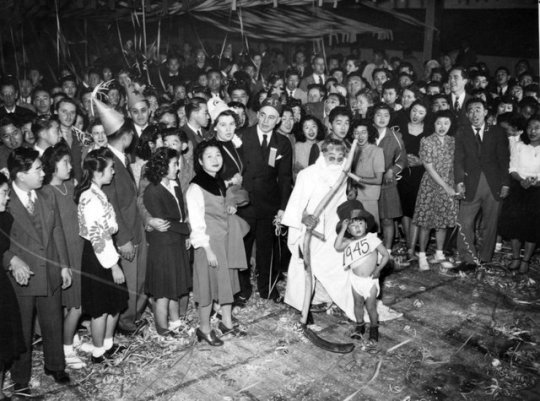
New Year’s Eve at Topaz internment camp, Central Utah Relocation Center, for Americans of Japanese ancestry. December 31, 1945. [1161 x 862] #HistoryPorn http://bit.ly/2Roh9pN
0 notes
Photo

🌸 My grandma was 13 years old when she and her family were evicted from their apartment in San Francisco as part of the mass incarceration of Japanese Americans in World War II. In spring of 1942, she was moved to the Tanforan Assembly Center, a former race track, where for half a year she lived with her parents and siblings in a single stall that still smelled of manure whenever it rained. That fall, they were shipped off to the Central Utah Relocation Center, known by the incarcerees as “Topaz”—a square mile of high desert surrounded by barbed wire and guard towers, where she started high school, met my grandfather, got her first job, and stayed until 1945, when the military orders prohibiting Japanese Americans from living on the west coast were finally lifted and she was able to move back to California.
.
She passed away long before I ever got the chance to ask about her time in the incarceration camps, but by all accounts she was something of a wild child—always arguing with her dad—and a social butterfly—always organizing dances and meetings of the Girl Reserves—and a heartbreaker—at any given time, she had several boys writing to her, and my grandpa in his early letters referred to her as “the Babe of Topaz.” (Here’s a photo of her at sixteen, on the camp JV basketball team, where I think her nickname was “Legs.”) From what I hear, Grandma was the kind of person who seized whatever opportunities she had and made the most of them, so even when she was unjustly imprisoned, she was living as big of a life as she could: borrowing her older sister’s clothes to sneak out to meet her friends at night, joining clubs, writing for the school newspaper, having long distance romances with boys in the army, one of which would eventually blossom into a entire, full lifetime of love. 💌
.
Happy Mother’s Day, Grandma. I wish I could’ve gotten to know you better, even though I think you were probably always too cool for me. 💞
.
(image: sepia-toned photo of a Japanese American girl from the 1940s in a white sports uniform posing with a basketball in an old gymnasium)
9 notes
·
View notes
Link
Born in Oakland, California, Korematsu was imprisoned at the Central Utah War Relocation Center at Topaz, Utah in 1942. The post Fred Korematsu Google doodle honors Japanese internment camp survivor & civil rights activist appeared first on Search Engine Land.
Please visit Search Engine Land for the full article.
Read the whole article: CLICK HERE
from Sniply: Search Engine Land: News & Info About SEO, PPC, SEM, Search Engines & Search Marketing
Brought to you by: PremierDetroitSEO.com
Brought to you by: PremierDetroitSEO.com
0 notes
Photo

“Topaz, Utah. Bennie Nobori, former animator in a Hollywood film studio, is now a cartoonist on the Topaz Times. Bennie has a regular cartoon strip which appears in the paper at the center…” 3/11/1943
Stewart, Francis, War Relocation Authority photographer, Series: Central Photographic File of the War Relocation Authority, 1942 - 1945. Record Group 210: Records of the War Relocation Authority, 1941 - 1989
Professional photographers were commissioned by the War Relocation Authority to document the daily life and treatment of Japanese-Americans who were interned during World War II.
Browse nearly 4,000 photos of Japanese American relocation and internment in the Central Photographic File of the War Relocation Authority in the @usnatarchives online catalog.

More Resources Commemorating the 75th Anniversary of Japanese American Internment at the National Archives
#Japanese American Internment#World War II#Cartoonist#cartoon#art#artist#Asian American History#ww2#WWII75#Topaz Relocation Center#Utah#Francis Stewart#March 11#1943#1940s
94 notes
·
View notes
Text
Fred Korematsu Google doodle honors Japanese internment camp survivor & civil rights activist
http://feeds.searchengineland.com/~r/searchengineland/~3/z8G8HowiAOY/fred-korematsu-google-doodle-honors-japanese-internment-camp-survivor-civil-rights-activist-268313
Born in Oakland, California, Korematsu was imprisoned at the Central Utah War Relocation Center at Topaz, Utah in 1942. The post Fred Korematsu Google doodle honors Japanese internment camp survivor & civil rights activist appeared first on Search Engine Land. Please visit Search Engine Land for the full article.
0 notes
Text
Topaz 1942 - 1946
Topaz 1942 – 1946
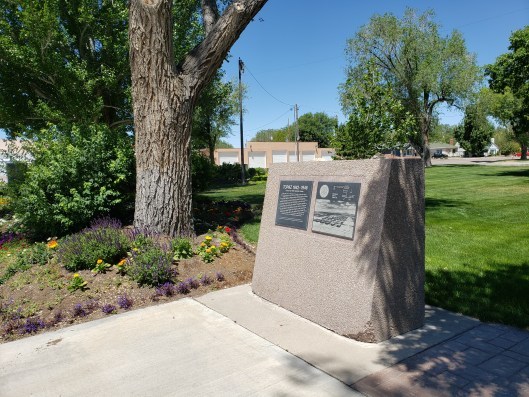
Topaz 1942 – 1946
Central Utah WRA Relocation Center
Fifteen miles west at Abraham is the location of the bleak desert site of a concentration camp, one of ten in Western America, in which 110,000 persons of Japanese ancestry were interned against their will during World War II. They were the victims of wartime hysteria, racial animosity, and economic opportunism on the West Coast.
Confi…
View On WordPress
#Concentration Camps#Delta#Historic Markers#Millard County#National Historic Landmarks#NRHP#utah#World War II
0 notes
Text
New Post has been published on Website Design Naples Florida Webmaster
New Post has been published on http://vinbo.com/fred-korematsu-google-doodle-honors-japanese-internment-camp-survivor-civil-rights-activist/
Fred Korematsu Google doodle honors Japanese internment camp survivor & civil rights activist
Born in Oakland, California, Korematsu was imprisoned at the Central Utah War Relocation Center at Topaz, Utah in 1942. The post Fred Korematsu Google doodle honors Japanese internment camp survivor & civil rights activist appeared first on Search Engine Land.
Please visit Search Engine Land for the full article.
Search Engine Land: News & Info About SEO, PPC, SEM, Search Engines & Search Marketing
0 notes
Text
Fred Korematsu Google doodle honors Japanese internment camp survivor & civil rights activist
Born in Oakland, California, Korematsu was imprisoned at the Central Utah War Relocation Center at Topaz, Utah in 1942. The post Fred Korematsu Google doodle honors Japanese internment camp survivor & civil rights activist appeared first on Search Engine Land.
Please visit Search Engine Land for the full article.
Fred Korematsu Google doodle honors Japanese internment camp survivor & civil rights activist
0 notes